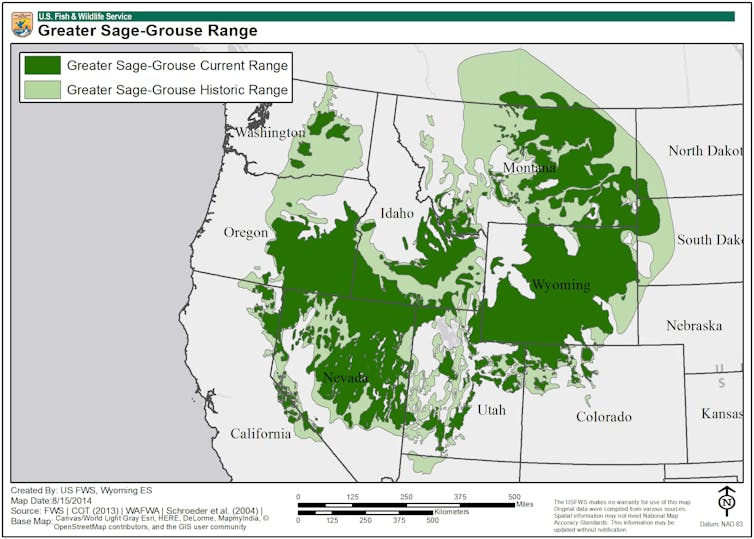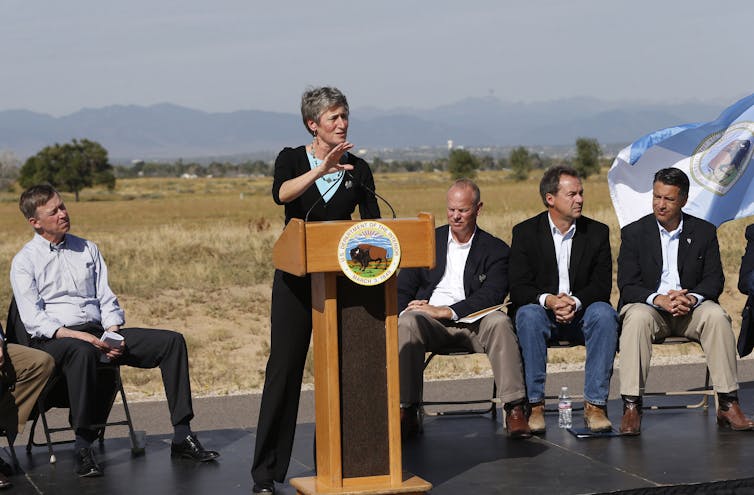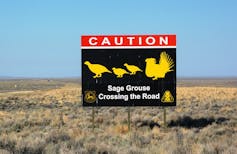The sage grouse isn't just a bird – it's a proxy for control of Western lands
- Written by John Freemuth, Professor of Public Policy and Executive Director, Andrus Center for Public Policy, Boise State University
The Trump administration is clashing with conservation groups and others over protection for the greater sage grouse[1] (Centrocercus urophasianus), a bird widely known for its dramatic mating displays. The grouse is found across sagebrush country from the Rocky Mountains on the east to the Sierra and Cascade mountain ranges on the west.
This region also contains significant oil and gas deposits. The Trump administration is revising[2] an elaborate plan developed under the Obama administration that sought to steer energy development away from sage grouse habitat. Conservation groups are suing in response[3], arguing that this shift and accelerated oil and gas leasing threaten sage grouse and violate several key environmental laws.
This battle is the latest skirmish in a continuing narrative over management of Western public lands. Like its Republican predecessors[4], the Trump administration is prioritizing use of public lands and resources over conservation. The question is whether its revisions will protect sage grouse and their habitat effectively enough to keep the birds off of the endangered species list – the outcome that the Obama plan was designed to achieve.
By popping their brightly colored air sacs, male sage grouse create a sound that can carry 3 kilometers to attract females to their display ground.Sage grouse under siege
Before European settlement, sage grouse numbered up to 16 million across the West. Today their population has shrunk to an estimated 200,000 to 500,000[5]. The main cause is habitat loss due to road construction, development and oil and gas leasing[6].
More frequent wildland fires are also a factor. After wildfires, invasive species like cheatgrass[7] are first to appear and replace the sagebrush that grouse rely on for food and cover. Climate change and drought[8] also contribute to increased fire regimes, and the cycle repeats itself.
Concern over the sage grouse’s decline spurred five petitions to list it for protection under the Endangered Species Act[9] between 1999 and 2005. Listing a species is a major step because it requires federal agencies to ensure[10] that any actions they fund, authorize or carry out – such as awarding mining leases or drilling permits – will not threaten the species or its critical habitat[11].
 Current and historic range of greater sage grouse.
USFWS[12]
Current and historic range of greater sage grouse.
USFWS[12]
In 2005 the U.S. Fish and Wildlife Service declared that an ESA listing for the sage grouse was “not warranted.” These decisions are supposed to be based on science, but leaks revealed[13] that an agency synthesis of sage grouse research had been edited by a political appointee who deleted scientific references without discussion. In a section that discussed whether grouse could access the types of sagebrush they prefer to feed on in winter, the appointee asserted, “I believe that is an overstatement, as they will eat other stuff if it’s available.”
In 2010 the agency ruled that the sage grouse was at risk of extinction, but declined to list it at that time[14], although Interior Secretary Ken Salazar pledged to take steps to restore sagebrush habitat[15]. In a court settlement, the agency agreed to issue a listing decision by September 30, 2015.
Negotiating the rescue plan
The Obama administration launched a concerted effort in 2011 to develop enough actions and plans at the federal and state level to avoid an ESA listing for the sage grouse. This effort involved federal and state agencies, nongovernmental organizations and private landowners.
California, Colorado, Idaho, Montana, Nevada and Wyoming all developed plans for conserving sage grouse and their habitat. The U.S. Forest Service and Bureau of Land Management revised 98 land use plans in 10 states. And the U.S. Department of Agriculture provided funding[16] for voluntary conservation actions on private lands.
In 2015 Interior Secretary Sally Jewell announced[17] that these actions had reduced threats to sage grouse habitat so effectively that a listing was no longer necessary. A bipartisan group of Western governors joined Jewell for the event. But despite the good feelings, some important value conflicts remained unresolved.
 Interior Secretary Sally Jewell announces the sage grouse rescue plan in Colorado, Sept. 22, 2015. Behind Secretary Jewell are, left to right, Colorado Gov. John Hickenlooper, Wyoming Gov. Matt Mead, Montana Gov. Steve Bullock, and Nevada Gov. Brian Sandoval.
AP Photo/Brennan Linsley[18]
Interior Secretary Sally Jewell announces the sage grouse rescue plan in Colorado, Sept. 22, 2015. Behind Secretary Jewell are, left to right, Colorado Gov. John Hickenlooper, Wyoming Gov. Matt Mead, Montana Gov. Steve Bullock, and Nevada Gov. Brian Sandoval.
AP Photo/Brennan Linsley[18]
Notably, the plan created zones called Sagebrush Focal Areas – zones that were deemed essential for the sage grouse to survive – and proposed to bar mineral development[19] on 10 million acres within those areas. Some Western governors, such as Butch Otter of Idaho, viewed[20] this element as a surprise and felt that it had been dropped on states from Washington, without consultation.
The Trump administration wants to cancel[21] creation of Sagebrush Focal Areas and allow mining and energy development in these zones. Agency records show that as Interior Department officials reevaluated the sage grouse plan in 2017, they worked closely with representatives of the oil, gas and mining industries[22], but not with environmental advocates.
Can collaboration work?
If the Trump administration does weaken the sage grouse plan, it could have much broader effects on relations between federal agencies and Western states.
Collaboration is emerging as a potential antidote to high-level political decisions and endless litigation over western public lands and resources. In addition to the sage grouse plan, recent examples include a Western Working Lands Forum[23] organized by the Western Governors’ Association[24] in March 2018, and forest collaboratives in Idaho that include diverse members[25] and work to balance timber production, jobs and ecological restoration in Idaho national forests.
 Warning sign in Wyoming.
Mark Bellis/USFWS, CC BY[26][27]
Warning sign in Wyoming.
Mark Bellis/USFWS, CC BY[26][27]
There are two key requirements for these initiatives to succeed. First, they must give elected and high-level administrative appointees some cover to support locally and regionally crafted solutions. Second, they have to prevent federal officials from overruling outcomes with which they disagree.
When the U.S. Fish and Wildlife Service announced in 2015 that an endangered listing for the sage grouse was not warranted, the agency committed[28] to revisit the bird’s status in 2020. To avoid having to list the grouse as endangered, the Trump administration must provide enough evidence and certainty to justify a decision not to list, as the Obama administration sought to do. If Interior changes land management plans and increases oil and gas leasing, that job could become harder. It also is possible that Congress might prohibit a listing[29].
Finding a lasting solution will require the Trump administration to collaborate with states and other stakeholders, including environmental advocates, and allow local land managers to do the same. Then, whatever the outcome, it cannot reverse their efforts in Washington. As Matt Mead, Wyoming’s Republican governor, warned[30] in 2017, “If we go down a different road now with the sage grouse, what it says is, when you try to address other endangered species problems in this country, don’t have a collaborative process, don’t work together, because it’s going to be changed.”
References
- ^ greater sage grouse (www.fws.gov)
- ^ revising (www.eenews.net)
- ^ suing in response (www.biologicaldiversity.org)
- ^ predecessors (upcolorado.com)
- ^ an estimated 200,000 to 500,000 (www.allaboutbirds.org)
- ^ oil and gas leasing (blog.nature.org)
- ^ cheatgrass (www.hcn.org)
- ^ Climate change and drought (doi.org)
- ^ Endangered Species Act (theconversation.com)
- ^ ensure (www.fws.gov)
- ^ critical habitat (www.fws.gov)
- ^ USFWS (www.fws.gov)
- ^ revealed (muse.jhu.edu)
- ^ declined to list it at that time (www.scribd.com)
- ^ restore sagebrush habitat (www.nytimes.com)
- ^ funding (www.everycrsreport.com)
- ^ announced (pubs.usgs.gov)
- ^ AP Photo/Brennan Linsley (www.apimages.com)
- ^ bar mineral development (www.blm.gov)
- ^ viewed (www.idahostatesman.com)
- ^ cancel (www.blm.gov)
- ^ representatives of the oil, gas and mining industries (psmag.com)
- ^ Western Working Lands Forum (westgov.org)
- ^ Western Governors’ Association (westgov.org)
- ^ diverse members (www.idahoforestpartners.org)
- ^ Mark Bellis/USFWS (flic.kr)
- ^ CC BY (creativecommons.org)
- ^ committed (www.fws.gov)
- ^ prohibit a listing (www.eenews.net)
- ^ warned (www.denverpost.com)
Authors: John Freemuth, Professor of Public Policy and Executive Director, Andrus Center for Public Policy, Boise State University

